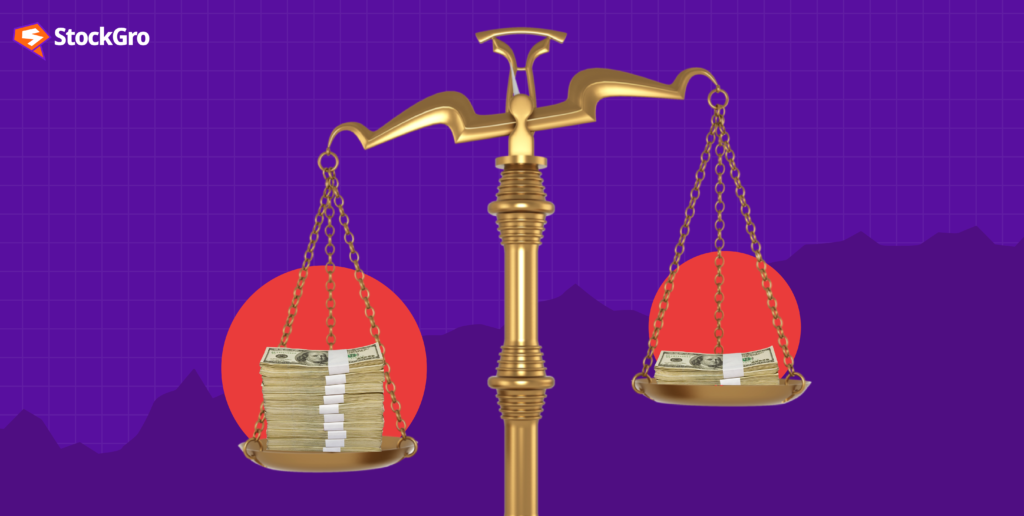
Margin trading is like getting a loan from your broker to invest in the stock market. It is akin to visiting a supermarket with just Rs. 50 in your pocket but magically walking out with a cart full of groceries worth Rs. 200. Sounds too good to be true, right? It might be if you don’t read the fine print.
What if I told you that over 90% of exchange trading volumes are leveraged trades, but they’re made by just about 15% of active traders? It’s like being part of an exclusive circle, but instead of a secret handshake, you’re delving into the world of borrowed funds.
But let’s take a step back for a moment. What exactly is margin trading?
What is margin trading and how does it work?
Margin trading, also known as margin buying, is a clever strategy that lets you buy securities or enter derivative contracts by borrowing cash from your brokerage firm. Here’s the twist: the very securities you purchase become your collateral.
But don’t forget, just like with any loan, you’re required to pay regular interest on the borrowed funds. To initiate a margin trade, investors must have a margin trading account with their broker.
In practical terms, margin trading allows investors to buy stocks by paying only a fraction of the actual value, known as the margin. This margin can be paid in cash or shares used as security.
Investors receive funding from their broker to execute margin trading transactions. If the profit earned from the trade is greater than the margin, investors will make a profit. However, if the investment loses value, the loss is magnified due to the leverage provided by margin trading.
Let’s say you decide to buy Rs. 10,000 worth of XYZ stock. You pay Rs. 5,000 in cash and borrow the remaining Rs. 5,000 through margin trading. If your investment grows by 25% to Rs.12,500, your actual return on investment would be 50% because you only invested Rs. 5,000 of your own money.
However, it’s important to note that margin trading can amplify both gains and losses. If your Rs10,000 investment decreases by 25% to Rs. 7,500, you will effectively lose 50% of your initial investment. So, while margin trading can be rewarding, it also comes with increased risk.
Additionally, brokers charge interest on margin loans, although the rates are typically lower than those of personal loans or credit cards.
You may also like: Germany falls into recession as inflation hits the economy; Here’s why
Eligibility for margin trading
To embark on the margin trading adventure, you’ll need to have a margin account with your trusted broker. This special account unlocks the door to the realm of margin trading facilities (MTF). But not everyone can waltz in and join the party. There are some eligibility criteria to fulfill. Here’s the scoop:
1. Opening the MTF account
To begin your margin trading journey, you’ll be required to open a margin account with your broker. The specifics of the margin requirements may vary among brokers, so it’s essential to familiarise yourself with their terms and conditions.
Remember, this is where the fun begins, as it’s not an open invitation for everyone. You’ll need to meet certain financial criteria set by your broker. They want to ensure that you have a solid foundation to play the margin trading game.
2. Minimum Balance Maintenance
Once you have your margin account up and running, there’s one golden rule you must follow: maintaining a minimum balance. Just like when you try to keep your bank account from dipping too low.
The minimum balance is the minimum amount of funds you need to have in your margin account at all times. Falling below this threshold is a big no-no. If you do, brace yourself for some consequences.
Your trade will be swiftly squared off, which means your position will be forcibly closed at the end of each trading session. So, don’t let your balance slip, and make sure to keep a watchful eye on it.
Also Read: Jio Financial Services: Disrupting the insurance and AMC markets
How is the margin calculated?
Margin is the magical moolah brokers lend you to make your trades even more exhilarating. But how do brokers decide how much margin to grant you? Well, here’s the lowdown:
- Margin percentage: Your margin percentage is determined based on the current market value of your portfolio. It serves as a guarantee that you have the financial muscle to back up your trades.
- Margin limit: The margin limit is the maximum amount of money your broker allows you to borrow. It’s calculated as a percentage of the total value of securities in your account.
- Let’s say your account holds securities worth Rs. 1 lakh, and your broker sets a 50% margin limit. That means they’re willing to lend you Rs. 50,000 to purchase more securities.
- However, keep in mind that brokers may offer different margin percentages based on their assessment of the lending risk involved.
- Calculating the Margin: To calculate the margin, subtract the total cost of securities from the total market value of securities. It’s like taking a leap of faith, seeing the difference between what you’ve paid and what they’re worth.
Features of margin trading
Amplified market exposure
- Leverage is the secret ingredient that fuels margin trading. With a generous 4X leverage, you can unleash the full force of your trading prowess.
- For instance, imagine your account holds assets worth Rs 10,000. Now, with the power of 4X leverage, you can increase your position size by a whopping Rs. 40,000.
Market opportunities
- Margin trading is not limited to derivative securities alone. You have the freedom to leverage positions in a variety of pre-defined securities approved by SEBI and respective stock exchanges.
Carrying forward positions
- The positions created with margin can be carried forward for a maximum of N+T days. N represents the number of days a position can be held, which may vary depending on the broker, while T corresponds to the trading days.
Understanding interest on margin trading
Interest on margin trading plays a significant role in brokerages’ revenue streams and profit models. By charging interest on margin loans, brokers can offer more competitive brokerage rates to customers.
The interest rates on margin funding are generally fixed but can be negotiated based on your relationship with the broker and the amount of business you provide.
Let’s decode that formula for calculating interest on margin trading positions:
Interest payable = (Rate/365) x principal x time But what do those terms mean exactly? Here's the lowdown: Rate: The annualised interest rate you agreed upon for the loan. Principal: This is the amount you borrowed, or simply put, the cold hard cash sitting in your margin account. Term: We're talking about the number of days you're borrowing, divided by 365 to annualise it.
Now, before you get too carried away, remember that this is just a general approach. Each brokerage has its own set of rules and regulations for margin funding.
To truly grasp the subject, make sure to have a chat with your broker or do some detective work in that fine print of the agreement.
Advantages of margin trading
Margin trading is not just about making bigger profits, but it offers several advantages that can enhance your investment experience. Let’s dive into the perks of margin trading:
- Seizing short-term opportunities: Margin trading can give you the flexibility to seize short-term opportunities you wouldn’t otherwise be able to afford. It allows you to make quick moves and potentially capitalise on market fluctuations.
- Building credit and discipline: Successfully managing margin trades requires discipline, research, and risk management. By honing these skills, you can become a more savvy investor and build a solid credit history.
- Flexibility and diversification: With increased buying power, you can build a more diversified portfolio and spread your investments across various stocks or sectors. This flexibility may allow you to manage risk more effectively and potentially enhance returns.
Also Read: Rebalancing your finances and inner zen!
Disadvantages of Margin Trading
Although margin trading offers enticing advantages, it’s essential to be aware of the potential risks involved. Let’s explore some of these risks:
- Interest costs: Margin trading isn’t free. Like any loan, borrowing money from your broker comes with interest. If your investments don’t perform well, you’ll still need to repay the loan with those interest payments. Ouch!
- Market volatility can bite: Stocks can be like wild roller coasters, and market volatility can wreak havoc on your borrowed investments. If the market takes a nosedive, your losses can pile up quickly, potentially leaving you in a sticky situation.
- Margin call: Brokers aren’t all rainbows and sunshine. They have a safety net called a margin call. If the value of your investments falls below a certain threshold, your broker may demand additional funds or start selling your assets to recover their loan. Not a fun position to be in!
The bottom line: While margin trading offers the allure of bigger gains and expanded investment opportunities, it’s essential to approach it with caution. Remember, with great power comes great responsibility – and margin trading is no exception!

